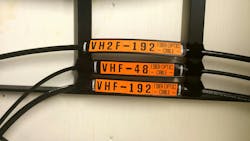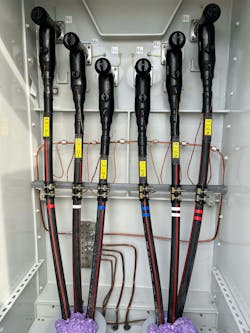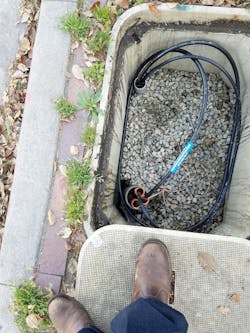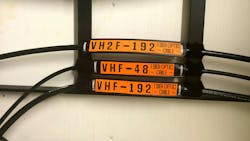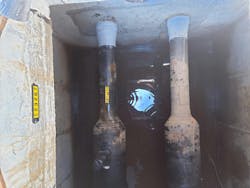Cable Markers Expedite Underground Fault Response
For electric utilities, even brief power outages can disrupt homes, businesses and critical infrastructure. These interruptions can also impact public safety and diminish customer trust, so quickly identifying and resolving electrical line faults is essential.
The challenges can be even greater with underground systems that distribute electricity through cables buried below ground. Unlike overhead lines, underground cables are not easily accessible. When a fault occurs, locating and repairing the problem often requires specialized tools and possibly excavation. Even minor failures can turn into extended outages.
To identify the probable location of the fault, lineworkers rely on data such as feeder loads, breaker activity and SCADA information before going out into the field to make repairs. However, this is where the work becomes more challenging. Physical signage at the site is a critical tool for directing utility crews to the precise location of underground cables, access points and other infrastructure so the work can begin.
Therefore, when cable markers are missing, mislabeled or damaged, the entire fault-response effort is delayed. Dispatchers often require more time to narrow down the field location. Technicians must wait for updated locations. Electromagnetic detection, ground-penetrating radar and vacuum excavation may be required.
This underscores the importance of signage that is accurate, visible and legible over many years, despite the harsh underground environment.
“Cable tags and markers play a critical role in warning utility personnel about potential hazards, but also can help utilities minimize any downtime by facilitating the location of cables and other equipment underground faster,” said Daniel O'Connor, general manager of Tech Products, Inc., a New York-based manufacturer of industrial identification solutions with more than 75 years of experience.
O'Connor emphasizes that markers that are “good enough” for a few years may be slightly less expensive but are ultimately poor choices in the long run.
“The graphics should remain highly visible and legible for 30 to 40 years after installation, even in harsh environments above and below ground,” O’Connor said.
Signs Everywhere
In underground electrical distribution systems, signage must be installed in several critical locations. The rules for signage are largely derived from OSHA regulations, the National Electrical Safety Code (NESC), the National Electrical Code (NEC) and ANSI standards for safety signage. Utilities also maintain their own detailed signage and labeling standards that often exceed the general codes.
Above ground, labels are posted on transformer enclosures, switchgear, cable risers, junction boxes and utility access points. Common warning signs include “DANGER: High Voltage,” “Underground Electric” and “Authorized Personnel Only.” Pad-mounted transformers and sectionalizing cabinets must include an equipment ID number, voltage and phase information, kVA rating and manufacturer information.
Below ground, buried cable marker tape is often placed 12–18 inches above URD cables or conduit with warning text such as “Caution: Buried Electric Line Below” to alert excavation crews that electrical lines are present.
In underground vaults, manholes and handholes, it is standard to label ducts, phases and splices, using durable cable tags that include circuit and feeder IDs. These tags serve as essential safety warnings and help to identify cable racks, grounding systems, junctions and protective devices.
Unfortunately, the same underground environmental conditions that affect cable systems can also have an impact on any installed signage. For example, moisture can cause painted and laminated signs to fade or delaminate. Temperature extremes can cause plastic signs to become brittle or warp. Exposure to chemicals can also degrade plastics and coatings.
All these factors make it essential for utility signage to be made from materials designed for long-term outdoor or underground use.
One of the most common options are write-on tags, which allow users to add information using Sharpies, pens or pencils on materials like plastic, paper, metal or coated cardboard.
Despite their simplicity and convenience, write-on tags have notable limitations. Handwritten information is often illegible and can smudge and fade over time. In addition, only some write-on tags are designed specifically for harsh environments like high-impact polyolefin plastic products.
For example, Tech Products offers a range of identification products for electric and gas utilities, telecommunication and cable companies, OEMs and pipeline companies.
Its EVERLAST cable tags and markers display text or pictograms that are permanently embedded through the entire thickness of the substrate. UV stabilizers and antioxidants are added to provide complete protection and weather resistance in all climates. The polyolefin plastic is impervious to sun, wind, rain, humidity, salt water, fumes and acid/alkali solutions.
The tags and markers are not painted or screened but instead designed with solid black polypropylene characters permanently embedded into the substrate. Custom wording, logos and a range of color options are available.
To speed the process of locating and isolating the exact URD cable or urban feeder during a fault or outage, the EVERLAST line includes phase markers in 1-in. and 3-in. sizes that indicate the phase (A, B, or C) of each line.
When close-up reading is required in tight or confined spaces, miniature markers with raised, 3D characters, called FastTags by Tech Products, Inc., remain legible even in low light, oily or dusty environments. The raised 3D characters are hot stamped with high-quality UV-stable foil and are nonconductive and non-corroding.
Underground Cabling Grows
Today, demand for underground electric cabling is only growing. Dense urban cores and downtown districts rely on underground networks because real estate is scarce, outages and safety incidents carry high consequences and aesthetics matter.
Regions exposed to severe weather and wildfire risk, including parts of California, Florida and Hawaii, increasingly place distribution feeders and laterals below grade to reduce tree contacts and wind‑borne faults. Planned communities, campuses and industrial parks frequently specify “no‑pole” covenants.
Given the increasing adoption of underground systems and with the stakes so high to quickly restore power, utilities need to effectively use industry best practice signage, tags and markers to help technicians quickly and safely identify and resolve any faults.
For more information, call 1-800-221-1311, email [email protected] or visit www.techproducts.com.
